Lin Huang
Accurate and scalable exchange-correlation with deep learning
Jun 18, 2025Abstract:Density Functional Theory (DFT) is the most widely used electronic structure method for predicting the properties of molecules and materials. Although DFT is, in principle, an exact reformulation of the Schr\"odinger equation, practical applications rely on approximations to the unknown exchange-correlation (XC) functional. Most existing XC functionals are constructed using a limited set of increasingly complex, hand-crafted features that improve accuracy at the expense of computational efficiency. Yet, no current approximation achieves the accuracy and generality for predictive modeling of laboratory experiments at chemical accuracy -- typically defined as errors below 1 kcal/mol. In this work, we present Skala, a modern deep learning-based XC functional that bypasses expensive hand-designed features by learning representations directly from data. Skala achieves chemical accuracy for atomization energies of small molecules while retaining the computational efficiency typical of semi-local DFT. This performance is enabled by training on an unprecedented volume of high-accuracy reference data generated using computationally intensive wavefunction-based methods. Notably, Skala systematically improves with additional training data covering diverse chemistry. By incorporating a modest amount of additional high-accuracy data tailored to chemistry beyond atomization energies, Skala achieves accuracy competitive with the best-performing hybrid functionals across general main group chemistry, at the cost of semi-local DFT. As the training dataset continues to expand, Skala is poised to further enhance the predictive power of first-principles simulations.
YOLO-PRO: Enhancing Instance-Specific Object Detection with Full-Channel Global Self-Attention
Mar 04, 2025Abstract:This paper addresses the inherent limitations of conventional bottleneck structures (diminished instance discriminability due to overemphasis on batch statistics) and decoupled heads (computational redundancy) in object detection frameworks by proposing two novel modules: the Instance-Specific Bottleneck with full-channel global self-attention (ISB) and the Instance-Specific Asymmetric Decoupled Head (ISADH). The ISB module innovatively reconstructs feature maps to establish an efficient full-channel global attention mechanism through synergistic fusion of batch-statistical and instance-specific features. Complementing this, the ISADH module pioneers an asymmetric decoupled architecture enabling hierarchical multi-dimensional feature integration via dual-stream batch-instance representation fusion. Extensive experiments on the MS-COCO benchmark demonstrate that the coordinated deployment of ISB and ISADH in the YOLO-PRO framework achieves state-of-the-art performance across all computational scales. Specifically, YOLO-PRO surpasses YOLOv8 by 1.0-1.6% AP (N/S/M/L/X scales) and outperforms YOLO11 by 0.1-0.5% AP in critical M/L/X groups, while maintaining competitive computational efficiency. This work provides practical insights for developing high-precision detectors deployable on edge devices.
Enhancing the Scalability and Applicability of Kohn-Sham Hamiltonians for Molecular Systems
Feb 26, 2025Abstract:Density Functional Theory (DFT) is a pivotal method within quantum chemistry and materials science, with its core involving the construction and solution of the Kohn-Sham Hamiltonian. Despite its importance, the application of DFT is frequently limited by the substantial computational resources required to construct the Kohn-Sham Hamiltonian. In response to these limitations, current research has employed deep-learning models to efficiently predict molecular and solid Hamiltonians, with roto-translational symmetries encoded in their neural networks. However, the scalability of prior models may be problematic when applied to large molecules, resulting in non-physical predictions of ground-state properties. In this study, we generate a substantially larger training set (PubChemQH) than used previously and use it to create a scalable model for DFT calculations with physical accuracy. For our model, we introduce a loss function derived from physical principles, which we call Wavefunction Alignment Loss (WALoss). WALoss involves performing a basis change on the predicted Hamiltonian to align it with the observed one; thus, the resulting differences can serve as a surrogate for orbital energy differences, allowing models to make better predictions for molecular orbitals and total energies than previously possible. WALoss also substantially accelerates self-consistent-field (SCF) DFT calculations. Here, we show it achieves a reduction in total energy prediction error by a factor of 1347 and an SCF calculation speed-up by a factor of 18%. These substantial improvements set new benchmarks for achieving accurate and applicable predictions in larger molecular systems.
Efficient and Scalable Density Functional Theory Hamiltonian Prediction through Adaptive Sparsity
Feb 03, 2025Abstract:Hamiltonian matrix prediction is pivotal in computational chemistry, serving as the foundation for determining a wide range of molecular properties. While SE(3) equivariant graph neural networks have achieved remarkable success in this domain, their substantial computational cost-driven by high-order tensor product (TP) operations-restricts their scalability to large molecular systems with extensive basis sets. To address this challenge, we introduce SPHNet, an efficient and scalable equivariant network that incorporates adaptive sparsity into Hamiltonian prediction. SPHNet employs two innovative sparse gates to selectively constrain non-critical interaction combinations, significantly reducing tensor product computations while maintaining accuracy. To optimize the sparse representation, we develop a Three-phase Sparsity Scheduler, ensuring stable convergence and achieving high performance at sparsity rates of up to 70 percent. Extensive evaluations on QH9 and PubchemQH datasets demonstrate that SPHNet achieves state-of-the-art accuracy while providing up to a 7x speedup over existing models. Beyond Hamiltonian prediction, the proposed sparsification techniques also hold significant potential for improving the efficiency and scalability of other SE(3) equivariant networks, further broadening their applicability and impact.
\underline{E2}Former: A Linear-time \underline{E}fficient and \underline{E}quivariant Trans\underline{former} for Scalable Molecular Modeling
Jan 31, 2025



Abstract:Equivariant Graph Neural Networks (EGNNs) have demonstrated significant success in modeling microscale systems, including those in chemistry, biology and materials science. However, EGNNs face substantial computational challenges due to the high cost of constructing edge features via spherical tensor products, making them impractical for large-scale systems. To address this limitation, we introduce E2Former, an equivariant and efficient transformer architecture that incorporates the Wigner $6j$ convolution (Wigner $6j$ Conv). By shifting the computational burden from edges to nodes, the Wigner $6j$ Conv reduces the complexity from $O(|\mathcal{E}|)$ to $ O(| \mathcal{V}|)$ while preserving both the model's expressive power and rotational equivariance. We show that this approach achieves a 7x-30x speedup compared to conventional $\mathrm{SO}(3)$ convolutions. Furthermore, our empirical results demonstrate that the derived E2Former mitigates the computational challenges of existing approaches without compromising the ability to capture detailed geometric information. This development could suggest a promising direction for scalable and efficient molecular modeling.
Physical Consistency Bridges Heterogeneous Data in Molecular Multi-Task Learning
Oct 14, 2024



Abstract:In recent years, machine learning has demonstrated impressive capability in handling molecular science tasks. To support various molecular properties at scale, machine learning models are trained in the multi-task learning paradigm. Nevertheless, data of different molecular properties are often not aligned: some quantities, e.g. equilibrium structure, demand more cost to compute than others, e.g. energy, so their data are often generated by cheaper computational methods at the cost of lower accuracy, which cannot be directly overcome through multi-task learning. Moreover, it is not straightforward to leverage abundant data of other tasks to benefit a particular task. To handle such data heterogeneity challenges, we exploit the specialty of molecular tasks that there are physical laws connecting them, and design consistency training approaches that allow different tasks to exchange information directly so as to improve one another. Particularly, we demonstrate that the more accurate energy data can improve the accuracy of structure prediction. We also find that consistency training can directly leverage force and off-equilibrium structure data to improve structure prediction, demonstrating a broad capability for integrating heterogeneous data.
Masked adversarial neural network for cell type deconvolution in spatial transcriptomics
Aug 09, 2024



Abstract:Accurately determining cell type composition in disease-relevant tissues is crucial for identifying disease targets. Most existing spatial transcriptomics (ST) technologies cannot achieve single-cell resolution, making it challenging to accurately determine cell types. To address this issue, various deconvolution methods have been developed. Most of these methods use single-cell RNA sequencing (scRNA-seq) data from the same tissue as a reference to infer cell types in ST data spots. However, they often overlook the differences between scRNA-seq and ST data. To overcome this limitation, we propose a Masked Adversarial Neural Network (MACD). MACD employs adversarial learning to align real ST data with simulated ST data generated from scRNA-seq data. By mapping them into a unified latent space, it can minimize the differences between the two types of data. Additionally, MACD uses masking techniques to effectively learn the features of real ST data and mitigate noise. We evaluated MACD on 32 simulated datasets and 2 real datasets, demonstrating its accuracy in performing cell type deconvolution. All code and public datasets used in this paper are available at https://github.com/wenwenmin/MACD and https://zenodo.org/records/12804822.
Infusing Self-Consistency into Density Functional Theory Hamiltonian Prediction via Deep Equilibrium Models
Jun 06, 2024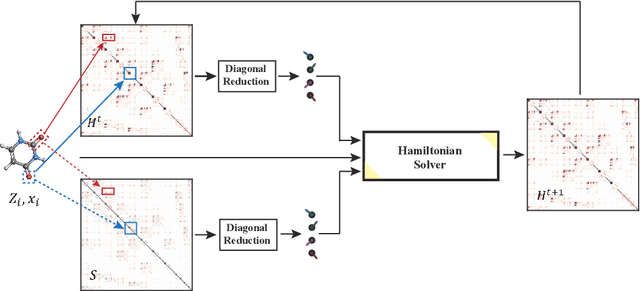
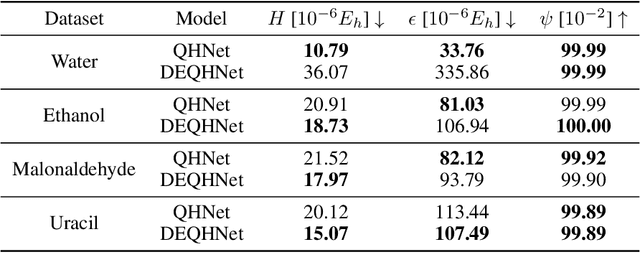
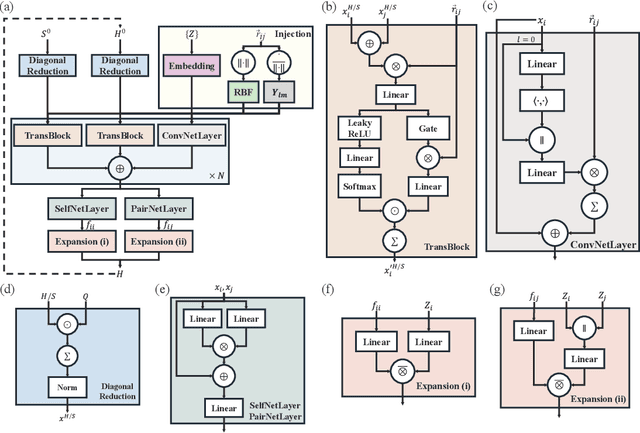

Abstract:In this study, we introduce a unified neural network architecture, the Deep Equilibrium Density Functional Theory Hamiltonian (DEQH) model, which incorporates Deep Equilibrium Models (DEQs) for predicting Density Functional Theory (DFT) Hamiltonians. The DEQH model inherently captures the self-consistency nature of Hamiltonian, a critical aspect often overlooked by traditional machine learning approaches for Hamiltonian prediction. By employing DEQ within our model architecture, we circumvent the need for DFT calculations during the training phase to introduce the Hamiltonian's self-consistency, thus addressing computational bottlenecks associated with large or complex systems. We propose a versatile framework that combines DEQ with off-the-shelf machine learning models for predicting Hamiltonians. When benchmarked on the MD17 and QH9 datasets, DEQHNet, an instantiation of the DEQH framework, has demonstrated a significant improvement in prediction accuracy. Beyond a predictor, the DEQH model is a Hamiltonian solver, in the sense that it uses the fixed-point solving capability of the deep equilibrium model to iteratively solve for the Hamiltonian. Ablation studies of DEQHNet further elucidate the network's effectiveness, offering insights into the potential of DEQ-integrated networks for Hamiltonian learning.
High-Performance Fine Defect Detection in Artificial Leather Using Dual Feature Pool Object Detection
Aug 16, 2023



Abstract:In this study, the structural problems of the YOLOv5 model were analyzed emphatically. Based on the characteristics of fine defects in artificial leather, four innovative structures, namely DFP, IFF, AMP, and EOS, were designed. These advancements led to the proposal of a high-performance artificial leather fine defect detection model named YOLOD. YOLOD demonstrated outstanding performance on the artificial leather defect dataset, achieving an impressive increase of 11.7% - 13.5% in AP_50 compared to YOLOv5, along with a significant reduction of 5.2% - 7.2% in the error detection rate. Moreover, YOLOD also exhibited remarkable performance on the general MS-COCO dataset, with an increase of 0.4% - 2.6% in AP compared to YOLOv5, and a rise of 2.5% - 4.1% in AP_S compared to YOLOv5. These results demonstrate the superiority of YOLOD in both artificial leather defect detection and general object detection tasks, making it a highly efficient and effective model for real-world applications.
Neural Voting Field for Camera-Space 3D Hand Pose Estimation
May 07, 2023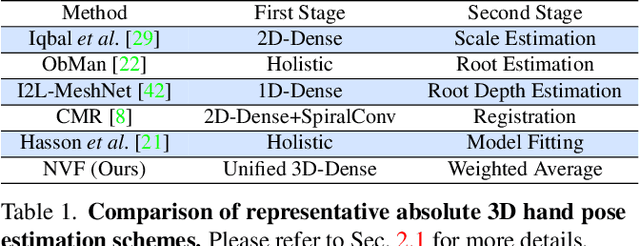
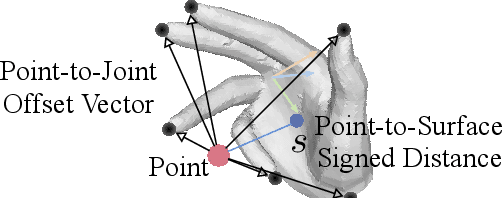
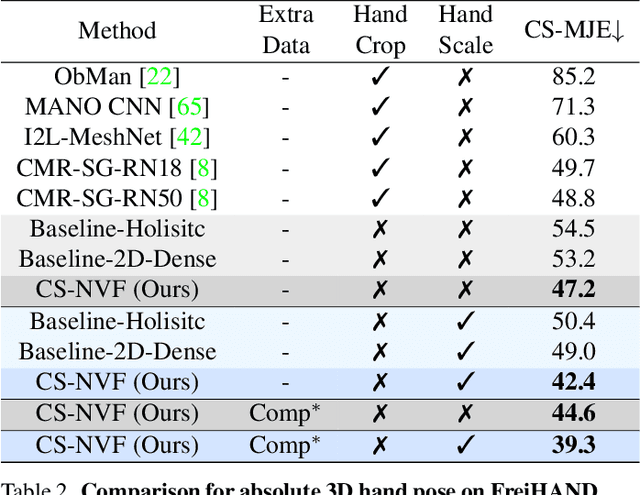
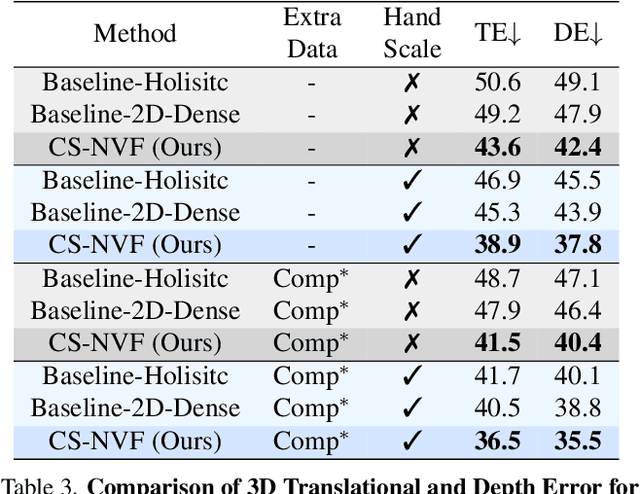
Abstract:We present a unified framework for camera-space 3D hand pose estimation from a single RGB image based on 3D implicit representation. As opposed to recent works, most of which first adopt holistic or pixel-level dense regression to obtain relative 3D hand pose and then follow with complex second-stage operations for 3D global root or scale recovery, we propose a novel unified 3D dense regression scheme to estimate camera-space 3D hand pose via dense 3D point-wise voting in camera frustum. Through direct dense modeling in 3D domain inspired by Pixel-aligned Implicit Functions for 3D detailed reconstruction, our proposed Neural Voting Field (NVF) fully models 3D dense local evidence and hand global geometry, helping to alleviate common 2D-to-3D ambiguities. Specifically, for a 3D query point in camera frustum and its pixel-aligned image feature, NVF, represented by a Multi-Layer Perceptron, regresses: (i) its signed distance to the hand surface; (ii) a set of 4D offset vectors (1D voting weight and 3D directional vector to each hand joint). Following a vote-casting scheme, 4D offset vectors from near-surface points are selected to calculate the 3D hand joint coordinates by a weighted average. Experiments demonstrate that NVF outperforms existing state-of-the-art algorithms on FreiHAND dataset for camera-space 3D hand pose estimation. We also adapt NVF to the classic task of root-relative 3D hand pose estimation, for which NVF also obtains state-of-the-art results on HO3D dataset.
 Add to Chrome
Add to Chrome Add to Firefox
Add to Firefox Add to Edge
Add to Edge